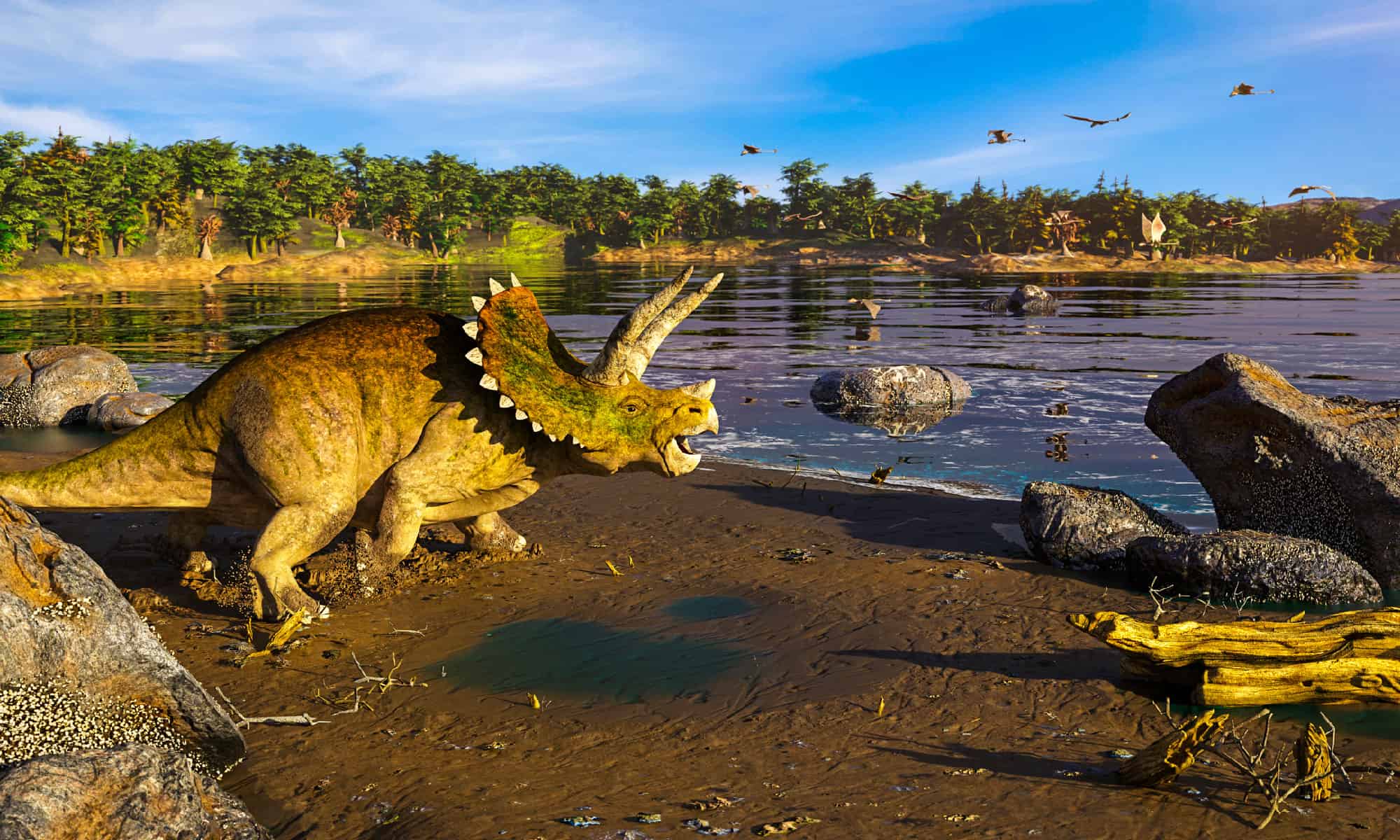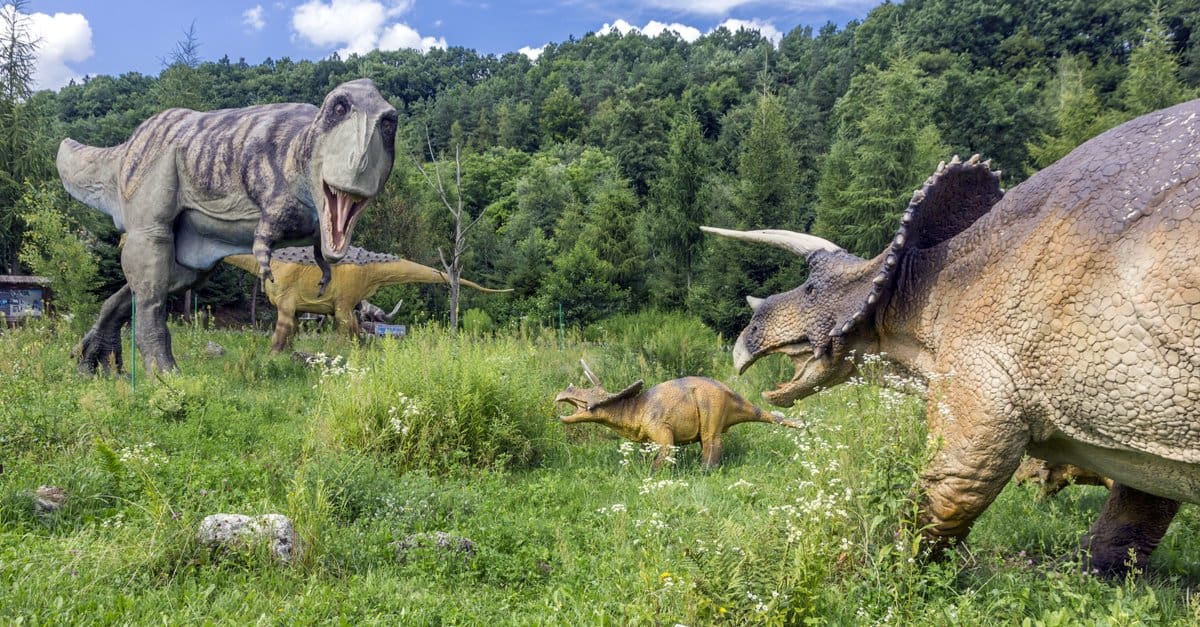Triceratops (Triceratops horridus) are fascinating creatures that lived during the late Cretaceous Period. Their name literally translates to “three-horned face.” These horns, along with their frill and parrot-like beak give triceratops their distinctive look.
Although triceratops lived millions of years ago, researchers have discovered a number of fossils of these creatures. The largest triceratops ever found is estimated to be taller than a moose and likely died following a battle with one of its own kind!
Discovery
In 2014 a paleontologist discovered the skeleton of an enormous tricerotops at Mud Butte Ranch in Southwestern Perkins County, near Newell, South Dakota, according to Guinness World Records.
After over a year of excavation and reconstruction, the creature’s mounted skeleton measured approximately 7.15 m (23 ft 5 in) long from snout to tail tip. The triceratops, nicknamed Big John, also measured 2.7 m (8 ft 10 in) high at the hips.
Triceratops skulls are typically measured using basal skull length (BSL), from the tip of the snout to the back of the occipital condyle. Big John’s skull has a BSL of 1.55 m (5 ft 1 in) — 5–10% larger than any other triceratops skull recorded so far.
Since it’s very rare to find full skeletons of triceratops, skull size is generally used to determine the size of these creatures. However, Big John’s skeleton is actually about 60% complete and he is by far the largest triceratops ever discovered.

Big John is the largest triceratops ever discovered and measures 23 ft 5 in long.
©iStock.com/dottedhippo
Ownership
After Big John’s discovery, he was purchased by a palaeontological preparation company called Zoic, located in Triest, Italy. The company, along with natural history expert Iacopo Briano, assessed, assembled, and measured the enormous skeleton over many months.
In 2021 Big John was sold for a record-breaking $7.7 million at an auction in Paris, according to the Tampa Bay Times. Tampa entrepreneur Sidd Pagidipati, a chairperson of Ayon Capitol and Better Health Group, made the winning bid.
Luckily, Pagidipati doesn’t plan on keeping Big John hidden away. By 2023 he announced his plans to donate the triceratops skeleton to the Glazer Children’s Museum in downtown Tampa for the next three years. The Big John exhibit opened on May 26.
How Did Big John Die?
Research on Big John’s remains shows that he likely died after fighting with another triceratops, reports NBC News. A study published in the journal Scientific Reports states that researchers found a significant injury in Big John — a large hole that pierced through thick bone.
This hole, located in Big John’s neck frill, was the exact size of the horn of a smaller triceratops. However, the battle itself isn’t what killed Big John. Examinations show that the wound started to heal when Big John died.
Paleontologist Ruggero D’Anastasio confirms that the triceratops may have developed a bacterial infection from the injury, which ended up killing him several months later. The bone surface around the gash even showed signs of inflammation.
So why was Big John locked in a fierce battle? While there’s no way to know for sure, D’Anastasio acknowledges that the fight may have been over a potential mate. Furthermore, broken fossils give researchers more information about how triceratops fought and interacted with each other.
Triceratops May Have Locked Horns in Combat
Smithsonian Magazine describes triceratops as unusual dinosaurs. Though triceratops are herbivores, research suggests they didn’t use their horns for defense against carnivores. Instead, they used them to fight among themselves by locking horns.
Raymond M. Alf Museum of Paleontology researcher Andrew Farke and colleagues found healed lesions on multiple triceratops’ skulls to support this theory of locking horns in combat with one another. Big John’s injury also may indicate that a slipped horn occurred during his fight.

Triceratops likely used their horns, not for defense against carnivores, but for fighting amongst themselves.
©Greir/Shutterstock.com
Other Notable Triceratops Fossils
Although Big John is the largest triceratops fossil, he isn’t the only notable triceratops remains that have been found. According to the Melbourne Museum, the first triceratops fossil was discovered in 1887. Scientists initially mistook the creature for some kind of bison.
Since then paleontologists have unearthed a number of triceratops fossils, including the remains of Big John and a triceratops named Horridus.
Horridus’ remains were discovered in Montana in 2014. Once excavations were complete, Horridus’ was shipped to Melbourne, Australia. There he was measured, labeled, and 3D scanned before making his public debut at the Melbourne Museum in Australia. Horridus is actually the most complete triceratops skeleton discovered so far and is over 85% intact.
The photo featured at the top of this post is © Dotted Yeti/Shutterstock.com
Thank you for reading! Have some feedback for us? Contact the AZ Animals editorial team.







